A birders’ paradise with a violent past.
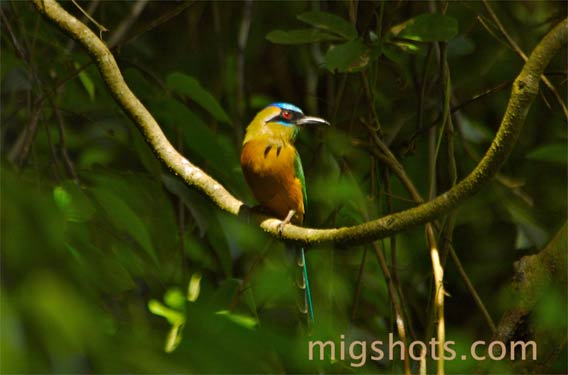
A motmot in Colombia’s Sierra Nevada. Photo by: Miguel Hernandez .
The highest coastal mountain on the planet rises 18,942 feet (5,775-meters) above the Caribbean Sea; it’s snow-capped peaks piercing through the clouds some 24 miles from an idyllic tropical beach. But to the casual visitor, the Sierra Nevada of Santa Marta in Colombia does not seem so grandiose. It slopes up and down until it disappears into the clouds, jealously concealing its tropical glacier. Somewhere up there, shrouded in mystery, like an ancient treasure, hides the most impressive summit in the Caribbean. People living along this part of the coastline say the snows of the Sierra are visible from some beaches, but to me they remain elusive even after many trips to the region. To catch a glimpse of the snows from the Caribbean would be a welcoming gift, but I have really come here to experience the Sierra, whatever it would reveal.
Cut off from the Andes, this unique pyramidal massif harbors every imaginable climate and ecosystem in the tropics, from desert-like environment along the coastline to tropical rain forest and cloud forest in the higher elevations. The result is an extraordinary exuberance of unique plants and animals, a biodiversity feast. But this is Colombia, a land of stark contrasts, of stunning natural beauty, of cocaine wars, of happy people living in the midst of a tacit war of powerful interests. The Sierra, as it turned out, has all these and more.
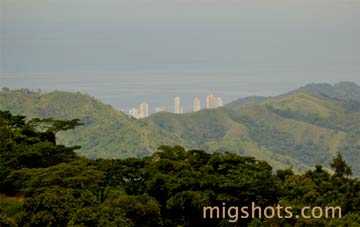 The view looking over Santa Maria. Photo by: Miguel Hernandez. |
My trip to the Sierra starts in Barranquilla, a large, bustling city on the Caribbean coast of Colombia. My two Colombian friends offer to take me in their small car. After a 30-minute drive on an unusually flat, two-lane road, the first silhouettes of the Sierra begin to appear like a mirage diffusing onto the horizon. We stop to pay a road toll and ask the attendant about the snow. She has seen it many times from here, especially after heavy rainfall, but not today. We continue driving towards the Sierra on this road that cuts through an extensive mangrove ecosystem along the coastline belonging to Isla de Salamanca National Park and Cienega Grande de Santa Marta Sanctuary (a UNESCO Biosphere Reserve). In the 1960s this road disrupted the natural flow of water to and from the ocean, resulting in the destruction of more than half of one of the most important fishing areas in the entire Caribbean basin. Four decades later the sun-bleached stumps of mangrove trees are still visible in the coastal marshes as a testament to human carelessness. We stop to take pictures along a deserted stretch of the road and I recognize familiar faces: roseate spoonbills, great blue heron, royal terns, wood storks, sandpipers; hundreds of them; migratory birds from North America wintering in Colombia, trying to cope with environmental upheaval.
We leave the flatness behind and come upon the first slopes of the Sierra that hug the coves and bays of Santa Marta, a seaside resort city. Its modern sector, el Rodadero, is built around a sandy bay crammed with high-rise buildings, hotels and restaurants, catering mostly to vacationing Colombians, but also to an increasing numbers of backpackers form Europe, the U.S. and Israel. It is November and the rainy season is making itself felt unusually violently in the region’s swelling rivers and flooding towns. Against the advise of locals, we decide to press ahead and continue towards Minca along the only paved road that climbs into the Sierra from here. Mudslides partially buried the road, we are told, but some cars are getting through. The first obstacle we encounter is a bridge, or rather the lack of one. A raging rapid the previous night had wiped it out. But a man signals us to take a detour into a private finca and cross where the stream eases and becomes shallow. We drive across the stream and ask the guy how much. “Whatever you want to give me.” We paid the ‘toll’ and continue, thinking, misery for some, opportunity for others. We zigzag our way up past fell trees, tons of mud and rocks, potholes, people riding tiny moto-taxis.
We are welcomed in Minca by a group of smiling police officers who ask us where we are headed. Their inquisitive eyes search for clues, trying to see beyond the obvious, examining our car and us. “Harmless tourists,” they probably realize. Then they joke and even recommend a couple of hotels in the tiny town, nestled in a cool mountain slope 2000 feet (650 meters) above the steaming Caribbean. A tropical cornucopia of trees, bromeliads, wildflowers, streams and birds greet us. But make no mistake, these guys in full combat regalia, machine guns drawn, are not in paradise, and are ready for whatever harm comes their way. A wall of black sandbags protects their station—I should say bunker.
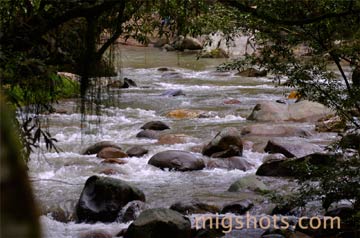 River in Colombia’s Sierra Nevada. Photo by: Miguel Hernandez. |
This reminds me of the Colombia we see in the news. Infamous violent groups, responsible for destabilizing the government and wrecking havoc in rural and remote regions during the last three decades, have each carved a niche in the Sierra Nevada of Santa Marta. Starting with drug traffickers who discovered “Colombian Gold” in the Sierra and set the stage for the marijuana bonanza of the 1970s, followed by leftist guerrillas and their arch-enemy—right-wing paramilitary death squads—the Sierra has had its undeserved share of problems. Its rugged terrain and inaccessible cloud-covered jungles have served the disparate groups well. The Sierra has been used as a hiding place, to grow marijuana and coca leaf, to refine coca into cocaine, and as a strategic corridor to ship illegal drugs to the Caribbean and the U.S. Today, however, a window of hope has opened in the Sierra, as in most of Colombia. In recent years, government crackdown on leftist guerrillas and drug traffickers, and a controversial peace treaty with paramilitary groups, have given the people of Colombia renewed optimism, and me and my two Colombian friends the courage to walk into the clouds of the Sierra.
We decide to stay at Hotel Sierra Sounds, next to the swollen river that cuts through Minca. It’s a small and pleasant house with a few rooms, fair food, a dinning area overlooking the river and no loud music. Rafa, the manager, befriends us immediately and serves us cold cervezas. Over the next few days we watch Northern Amazon red squirrels (very unusual in a Colombian town), howler monkeys, colorful humming birds, crested oropendolas, motmots, silver plate tanagers, jacamars and many other birds from the hotel. After an enjoyable sojourn in Minca bird-watching and hiking to waterfalls and wooded surroundings, I make plans to continue to the higher elevations and into the National Park Sierra Nevada of Santa Marta, a UNESCO-declared Biosphere Reserve that covers nearly one million acres of mostly montane forests and a transect right down to the Caribbean.
But first I must find a reliable guide who can take me there. Asking around I find Roberto [fictitious name to protect his identity], a local bird enthusiast who has worked with visiting scientists and birdwatchers in the past. He is a fit man in his early 30s who claims he can identify over 100 species of birds by both their Spanish and scientific names. His quiet and serene personality is reassuring. I decide to go with him.
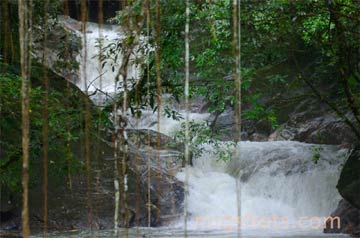 Waterfall in Colombia’s Sierra Nevada. Photo by: Miguel Hernandez. |
From Minca the road deteriorates into a rocky and muddy trail hard to negotiate in the rainy season. Only a few moto-taxis and the toughest 4-by-4 are up to the job. So our only options are to hike or ride on the back of a moto-taxi—a go-anywhere vehicle I can afford. I opt for a combination of the above: to go up as much as possible on a motorcycle to save time and continue on foot thereafter. Early in the morning I hesitantly hop on the back of a small motorcycle driven by a young guy, too young to trust. Roberto follows suit on another motorcycle. But as we were to find out, they are skillful drivers and tackle the rugged and often dangerous trails of the Sierra surprisingly well. Here, as in most rural Colombia, the motorcycle has replaced the mule and the donkey as the most efficient means of transportation, Juan Valdez notwithstanding. We set off for the main entrance of the National Park. My friends decide to stay in Minca enjoying the scenery, avoiding roughing it.
In the early morning mist the green mountains of Minca appear wooded and mysterious, but as we ride higher into the mountains, the sun rises and reveals its scars. Instead of thick forests we see pastures, farms, coffee plantations, cattle ranches, eroded slopes, widespread deforestation. Little, it seems, is left of the dry and tropical rain forests that once covered this section of the Sierra. Later I found out that only about 15 percent of the original forests that covered the highest coastal mountain on the planet have survived the onslaught of modern man. Illegal farming, mainly marijuana and coca, responding to international market demands is to blame for most of the deforestation of the Sierra. To top it off, the government’s main weapon to fight illegal crops has been aerial spraying with dangerous herbicides such as glyphosate and paraquat, which has been highly controversial in Colombia due to its negative effects on the environment and human health. The going is especially difficult for the motorcycles, which buck and stall insistently on the steep, rocky and wet trail. We get off and push, water rushing through our boots. We repeat the procedure a few times and keep on. As we approach the end of our motorcycle ride, the landscape begins to change. Green, steep and forested ridges await us in the distance, where colder climate has kept coca and marijuana at bay (fortunately for the forests they don’t do well in higher elevations). The air turns colder and more humid. While we say goodbye to our moto-taxi drivers the cloud cover opens up and greeted us with a magnificent view to the Cienega Grande de Santa Marta and the Caribbean Sea on the background. But it only lasts a few minutes, barely enough to snap a few pictures.
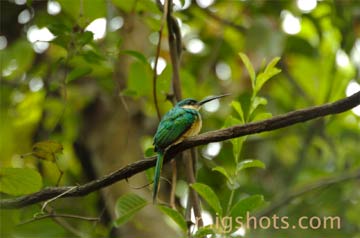 Female rufous-tailed jacamar (Galbula ruficauda). Photo by: Miguel Hernandez. |
I get my camera, tripod and lenses ready to photograph what the Sierra is most famous for among naturalists: birds. It is hard to believe that here in the Sierra 628 species of birds have been recorded (about the same number of species found in the U.S. and Canada combined). In fact, the Sierra Nevada of Santa Marta is now considered the world’s most important home for endemic birds (meaning that they exist nowhere else on the planet), containing 18 endemic species and 55 endemic subspecies. Despite the destruction, the diversity of birds is astonishingly evident everywhere. We started hiking at about 7 am and some two hours later we came upon el Dorado, a nature reserve set aside by Colombia’s NGO Fundacion Proaves to protect birds and their habitats, especially the critically endangered and endemic birds such as the Santa Marta Parakeet. Roberto explains that some of the birds we see here are unknown in Minca, some 15 miles down the road, because they can only survive at this altitude. So as we ascend, most of the fauna and flora change accordingly.
At El Dorado, Roberto identifies several species of rare birds, some endemics such as Yellow-crowned Whitestart, others more familiar like toucans and hawks. Located next to the National Park, El Dorado is a newly created reserve with wooden cabanas built to house scientists and birdwatchers, I am told by an overseer. Birdwatchers this far up in the Sierra? I wonder. With all the bad publicity and reputation about Colombia in general, and the Sierra in particular, this sounds unlikely. We continue hiking uphill towards the Park on the same dirt road, now cutting through thick vegetation and numerous streams and small waterfalls. We are entering the cloud forest some 6,000 feet (2000 meters) above sea level, and sure enough we literally walk into the clouds. We sit down to rest enveloped in an eerie billow, and Roberto begins to open up. Up until now he has kept a prudent distance from uncomfortable topics. Like most people in this region affected by political violence, he is very cautious when talking to outsiders beyond avian matters. But as we become acquainted with each other, he ventures out and tells me about the past.
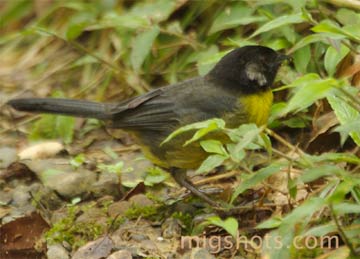 A Santa Marta brush finch (Atlapetes melanocephalus), which is endemic to Colombia. Photo by: Miguel Hernandez. |
The guerrilleros (guerrillas) came to this region in the late 1980s, they attacked the police station and occupied Minca for a short period killing police officers and innocent people in the process. They used intimidation, kidnapping and extortion to advance their political agenda against rich landowners and the government and to control this region. Later came the paramilitary death squads on a brutal crusade to exterminate left-wing guerrillas, committing untold atrocities, including torture, murders and massacres. Anybody suspected of being a guerrilla, or aiding one, was be put to death often by despicable methods. So the people of the Sierra Nevada of Santa Marta were either forced to flee to the slums of large Colombian cities or live under the Paramilitaries reign of terror. Roberto had no choice but to stay. “Down there,” he said, pointing towards el Dorado, “an old lady and his son were burned alive after the paracos (paramilitaries) set their house ablaze. They were unjustly accused by other people of being guerrilla collaborators. My childhood friend was captured by the paracos and locked in a room, but suspecting he was going to be tortured to death, he committed suicide. He hanged himself. He did nothing wrong, but he didn’t give them the pleasure of killing him.” He goes on. “We lived in terror for many years. Many people were murdered and tortured, and the police knew it. The paracos were the masters and lords of this land—they controlled everything. Then one day about two years ago the police and the army started attacking the paracos until they were captured or chased away. Now we have peace, but we don’t know if it’s going to last. Most people lost relatives and are mourning, but they are too afraid to talk. One day I know they will.” There was a sign of relief on Roberto’s face.
The air clears and we instinctively get up and continue walking in a silent, almost solemn manner, immersed in our own thoughts. The Caribbean glitters in the distance fusing with the horizon for a few minutes then clouds take over everything again. I am here watching birds, innocent people were brutally murdered here not too long ago—it just doesn’t feel right. Out of the clouds in front of us, a shiny white pickup truck appears, two beautiful women inside wave us hello, an unearthly apparition indeed, and continue their journey down the road. The vision was real, but I think magic realism. Suddenly I do not feel so isolated anymore. Later we encounter a group of five people attentively looking through binoculars, clad in khaki-colored, explorer’s cloths, and carrying small backpacks and notebooks. Unmistakable birdwatchers, I think. We say hello, shake hands and introduce ourselves in line with Colombian traditions. We speak in Spanish and they tell me they are from the U.S., Canada and Germany. Well-groomed and speaking with a Bogota accent, the guide explains to me that they are part of an organized birdwatching tour from Proaves. They hastily look at a few photos of birds on my camera screen, identify them and continue their quest for some of the rarest birds on the planet. Later we stumble upon a larger group of birders busily pointing towards the canopy and looking through binoculars. They sound Eastern Europeans and are too busy to socialize. Along with a few diehard backpackers and adventurers, birdwatchers seem to be the first international tourists who have found the Sierra Nevada of Santa Marta irresistible despite its recent violent past. The lure of fluttering, colorful wings is just too much.
At about 8000 feet (2500 meters), the entrance to the Sierra Nevada National Park is not impressive, much of it covered by an exotic species of pine introduced decades ago to reforest the nearby hills, but they are now considered a pesky invader competing with native species. A park official explains that the park actually begins higher up. The view, however, is breathtaking, when clouds clear out that is. There are a few cabanas offering basic accommodations. An old Toyota Land Cruiser is being unloaded. “Provisions for the group that just arrived,” the park official tells us. There is a few more houses scattered around the area which I assume are offices and lodging for park personnel. We continue hiking into the park for another hour or so with the hope of seeing the snowy peaks from the next lookout point, as we are told it may be possible. It is midday now and we are very hungry; we stop to rest and eat the lunch we have been carrying in our backpacks since we left Minca.
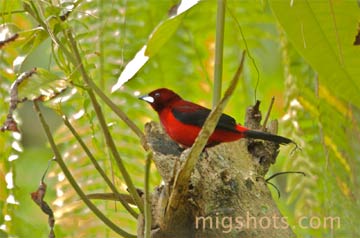 Silver-beaked Tanager (Ramphocelus carbo). Photo by: Miguel Hernandez. |
The Sierra is unrelenting and does not reveal its precious tropical glacier, revered by its indigenous people since ancient times. Up until now we have not seen any of the indigenous people who inhabit the Sierra Nevada today, descendants of an ancient civilization know as the Tayrona. Most local people we have seen so far are colonos or peasants and landowners from the lowlands or interior regions of Colombia. They have come here attracted by the economic bonanzas of the past: marijuana, coffee, cocaine, logging, even the war. But where are the descendants of the ancient civilization known to have built intricate stone pathways and settlements and who flourished in pre-Colombian times? Roberto tells me they are near, but they don’t like to mingle with outsiders—and by that I mean anybody who came after Columbus.
The most notable of the surviving indigenous groups of the Sierra is the Kogi, who have been the subject of considerable media attention both nationally and internationally. Their tenacity to cling to their traditions and ancient land in the face of formidable threats, their ecological world view, their distinctive way of life and their peaceful nature have won them a venerable place among the great conservationists of our times. Without having left their forests, the Kogi people know we humans are causing irreparable damage to the planet. Their snows are receding faster than ever, rivers and streams are drying up and deforestation is rampant, the climate is changing like never before—the Sierra, the heart of the world—is dying. We, their younger brothers, must change our destructive ways: this was the warning they sent to the world back in 1988 when a BBC film crew entered their secret territory and filmed their remarkable culture. This extraordinary society has been living in the upper ridges of Sierra unconquered and uncontaminated by modern civilization since the conquistadores failed to subdue them more than four centuries ago. And they remember—as if it were yesterday—when the powerful, bearded white man, clothed in metal armor burst into their territory looking for gold and destroying everything in their path. The warning of the Kogi people echoes in today’s world more than ever. Twenty some years later, I think of a similar message, this one from some of brightest scientists in the world, the U.N. intergovernmental Panel on Global Climate Change. Simply put: we are altering the planet; we must change our ways or suffer the consequences.
We turn back and start our long descent towards Minca. It is all downhill from here so we figure we can make it down before nightfall. We are wrong. Before we walk out of the cloud forest, Roberto spots other interesting species including emerald green toucanets, which I try to photograph, not very successfully, for the next two hours. Most of them are perched too high on the canopy where I am unable to take clean shots. By the time I finally give up, we realize we’re not going to make it before nightfall. I check my backpack for a flashlight and remember I left it at the hotel. “Don’t worry, I have one,” Roberto reassures me.
Some three hours later down the trail in pitch dark I ask Roberto to use his flashlight. He takes out his cellular phone and out comes a dim light barely able to reach two feet in front of us. This is his version of a flashlight. It is better than nothing, but we have to slow down to avoid stepping on a poisonous snake, which are very common in this part of the Sierra. After more than 14 hours of hiking and birding we are exhausted and ready to quit when suddenly the road is lit up, magically. It’s a car going down our way. I instinctively stick my thumb out and the car stops. It is an SUV full of people, we can’t see their faces in the dark, but someone says there is no room for us inside but we can ride on the rear bumper. No problem, we jump on it without blinking and cling to whatever we can. A gust of cold air on our faces reminds us we are still high in the Sierra. Hugged to the roof of a truck, tiptoed on the bumper, backpack strapped to our backs, we descend into the night. Relieved and lucky, I wonder about the Sierra: its people, a paradise turned hell and back again; its melting snows that I never saw. We find Minca asleep and peaceful.

Above 2000 meters. Photo by: Miguel Hernandez.
Related articles
First-ever photo of rare and spectacular hummingbird from Colombia
(03/31/2010) A conservationist has taken the first-ever photos of a living Santa Marta Sabrewing (Campylopterus phainopeplus) in the El Dorado Nature Reserve in the Sierra Nevada de Santa Marta in Colombia, reports ProAves, a bird conservation group.
Cocaine production killing Colombia’s rainforests
(01/24/2011) Researchers have found that coca cultivation is associated with high rates of forest loss, at least in the southern forests of Colombia. According to a new paper just published in Environmental Science and Technology, areas near new coca plots are significantly more likely to suffer from forest loss. Politicians, environmental groups, and others have long attributed deforestation to coca production. But these researchers are the first to quantity the effect of coca cultivation while controlling for other factors.
‘Environmental and social aggression’: oil exploration threatens award-winning marine protected area
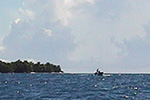
(12/01/2010) The Seaflower Marine Protected Area (MPA), which recently won top honors at the Convention on Biological Diversity (CBD) in Japan, is now under threat by planned oil exploration in the region, according to the Providence Foundation which is devoted to protecting the area. Proposed blocs for exploration by the Colombian government lie in the North Cays adjacent to the park, and perhaps even inside MPA boundaries. Spreading over 65,000 square kilometers (6.5 million hectares), Seaflower MPA lies within the Colombian Caribbean department known as the Archipelago of San Andres, Old Providence and Santa Catalina. This richly diverse Archipelago is home to a known 57 coral species, over 400 fish, and some 150 birds, as well as the ethnic and cultural minority: the Raizal people. The prospect of massive infrastructure or, even worse, oil spills in the area could devastate the park and locals’ livelihoods.
Discovery of new population boosts almost-extinct Colombian bird

(09/28/2010) The Baudo oropendola (Psarocolius cassini) has gone from less than a dozen known individuals to nearly a hundred due to the discovery of two new colonies in northwestern Colombia by local conservation group, Fundación ProAves. However, the new colonies are located in an unprotected area currently being impacted by deforestation. George Fenwick, president of American Bird Conservancy which focuses on bird conservation, said in a press release that his organization “is thrilled to have helped fund the research expedition that led to this stunning discovery of these two new colonies of this rare bird. Now we need to work with ProAves to conserve and protect them.”
New bird discovered in Colombia—and released alive

(05/26/2010) Researchers have discovered a new species of antpitta in the montane cloud forests of the Colibri del Sol Bird Reserve in western Colombia. A thrush-like bird, the new cinnamon and gray species was, according to a press release by the American Bird Conservancy (ABC), “captured, banded, measured, photographed, sampled for DNA, and then released alive back into the wild”. This is one of only a few incidences in which a new species has been described without ‘collecting’ an individual (i.e. killing) to provide a model of the species in a museum. The new bird has been named Fenwick’s antpitta (Grallaria fenwickorum) after the President of ABC, George Fenwick, and his family.
Taking back the rainforest: Indians in Colombia govern 100,000 square miles of territory

(05/10/2010) Indigenous groups in the Colombian Amazon have long suffered deprivations at the hands of outsiders. First came the diseases brought by the European Conquest, then came abuses under colonial rule. In modern times, some Amazonian communities were virtually enslaved by the debt-bondage system run by rubber traders: Indians could work their entire lives without ever escaping the cycle of debt. Later, periodic invasions by gold miners, oil companies, colonists, and illegal coca-growers took a heavy toll on remaining indigenous populations. Without title to their land, organization, or representation, indigenous Colombians in the Amazon seemed destined to be exploited and abused. But new hope would emerge in the 1980s, thanks partly to the efforts of Martin von Hildebrand, an ethnologist who would help indigenous Colombians eventually win control over 260,000 square kilometers (100,000 square miles) of Amazon rainforest—an area larger than the United Kingdom.

(11/03/2009) Reducing Emissions from Deforestation and Degradation (REDD), a climate change mechanism proposed by the U.N., has been widely lauded for its potential to simultaneously deliver a variety of benefits at multiple scales. But serious questions remain, especially in regard to local communities. Will they benefit from REDD? While much lip-service is paid to community involvement in REDD projects, many developers approach local communities as an afterthought. Priorities lie in measuring the carbon sequestered in a forest area, lining up financing, and making marketing arrangements, rather than working out what local people — the ones who are often cutting down trees — actually need in order to keep forests standing. This sets the stage for conflict, which reduces the likelihood that a project will successfully reduce deforestation for the 15-30 year life of a forest carbon project. Brodie Ferguson, a Stanford University-trained anthropologist whose work has focused on forced displacement of rural communities in conflict regions in Colombia, understands this well. Ferguson is working to establish a REDD project in an unlikely place: Colombia’s Chocó, a region of diverse coastal ecosystems with some of the highest levels of endemism in the world that until just a few years ago was the domain of anti-government guerillas and right-wing death squads.